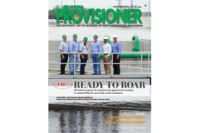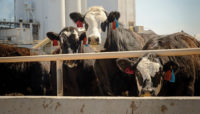JBS: Ready to roar
If recent investments made by JBS to improve its impact on the environment, the community and its own employees are any indication, this global behemoth may be poised for a run of impressive growth.










Like many other companies, JBS had been operating under sustainable guidelines prior to the “green movement,” explains Cameron Bruett — named chief sustainability officer for JBS USA in late spring 2012.
“We’ve always tried to engage with the community, we’ve always tried to make our operations more efficient and be responsive to the environment, but I think now we’re embarking on a new phase where we define it as sustainability,” he says. “We track it, we monitor it, we look at our progress and we drive improvement under that concept.”

|
|
McDonald’s ‘BOSS’ awards primer The National Provisioner asks Bob Langert, vice president of Sustainability, McDonald’s Corp., for insight into the McDonald’s “Best of Sustainable Supply” (BOSS) awards program. NP: In brief, what makes McDonald’s Best of Sustainable Supply 2012 winners really stand out, given that most companies are pushing sustainability programs heavily nowadays? Langert: Each company delivered measurable results in innovative ways. McDonald’s and our outside judges (from the World Wildlife Federation, Conservation International and Farm Animal Initiative) were impressed at how many of the winning companies let employees lead significant change. In some cases, competitors worked together to address an issue. One example is French fry suppliers (McCain Food, J.R. Simplot and ConAgra Lamb Weston) collaborating to develop Integrated Pest Management/Integrated Chemical Management programs that will help ensure a sustainable potato supply. NP: Specifically regarding the JBS wastewater initiative, what were the keys to McDonald’s choosing JBS for the honor? Langert: First, JBS provided solid data to demonstrate results. And the judges liked those results: helping protect the environment, lessening the impact of JBS production facilities in local communities and improving the bottom line. JBS says the wastewater treatment program demonstrates that “an environmentally minded company results in a sustainable business.” We agree. NP: Were there any surprises around any of the meat and poultry winners? Langert: We’re pleased, but not surprised, that our suppliers actively focus on helping their people and communities, a core value they share with McDonald’s. Great examples: Smithfield Foods and its effort to encourage a culture of safety at every level of operations; Cargill’s school in Thailand that helps employees complete their education while working and getting paid; and Burnbrae Farms’ providing chickens, coops and guidance on raising poultry at an orphanage in Belarus. —Andy Hanacek |
What separates JBS’ efforts, however, is its ability to use its sheer global size to its advantage. Bruett works closely with the sustainability teams across JBS USA facilities (headquartered in Greeley, Colo.) to find and share best practices — a task that has reaped rewards for the company time and again, and this year culminated in two initiatives winning McDonald’s Corp. “Best of Sustainable Supply” awards. (For details on the awards program, see “McDonald’s ‘BOSS’ awards primer” sidebar.)
“We try to drive a clear sustainability agenda throughout our U.S. units,” he adds. “Then we coordinate with what the parent company is doing in Brazil and what we’re doing in Australia and other countries in which we operate.
“So it’s really an aggressive time for us in this space here in the States,” Bruett admits. “It’s actually a pretty exciting time.”
Water reduction recognition
In today’s digital, global world, it seems easy to collect recognition for deeds done well, but when a company such as McDonald’s chooses the best sustainable initiatives driven by its supply-chain partners, people take notice. For the 2012 awards program, the foodservice giant accepted more than 400 submissions and honored 40 companies for 51 different initiatives, including several protein companies.
JBS USA received awards for two of its initiatives:
- Recovering Animal Grease from Dissolved Air Flotation Units
- Reducing Water Usage in Arid Regions
Damon Depew, corporate environmental engineer for JBS USA, says the awards are indicative of larger, company-wide successes. For example, JBS USA won one award for water reduction for two plants (Greeley, Colo., and Cactus, Texas), but they weren’t the only plants to reduce their water usage significantly.
“Grand Island (Neb.) had seen the same kind of reduction numbers, but it wasn’t considered to be in an arid region,” Depew explains. Water usage numbers, he adds, come directly from each plant’s municipal water bills, and the numbers cover all aspects of operations, from the time cattle enter the facility all the way through the process.
Although the award for water reductions was given for successful initiatives in the 2010-2011 timeframe, improvements in water-efficiency have continued, and the Grand Island facility has the statistics to show it.
According to John Ditter, environmental manager at Grand Island, the facility had further reduced its water usage by 20 percent dating back to January 2011.
“We’re saving 208 million gallons a year — we were running over 21 million gallons a week January 2011, and we’re running 17 million gallons [at the end of May],” Ditter says. He pinpoints continued employee education and vigilance around the goals of reducing usage, as well as technological investment in equipment such as efficient spray nozzles and recycling cabinets, as catalysts for the further reductions.
Also, the Grand Island team has partnered with its third-party sanitation company to clean the plant thoroughly every night without wasting water, and some effluent water is used to wash the driveways outside rendering facility and water the landscape and lawns.
Adding clarity, gaining byproducts
On the wastewater side, JBS has made significant investments in recent years to vastly improve its treatment process. Although Grand Island is not alone in benefitting from these investments, JBS invited The National Provisioner to tour the facility as a microcosm of the corporate-wide efforts that garnered the McDonald’s recognition.
With the wastewater-treatment system, the idea had never been to simply meet requirements, since those are constantly in flux. Instead, investing in any sustainable system is about preparing for the future, says Chuck Lamb, general manager at Grand Island.
“These laws and regulations are not going to get more lenient, and when you build something, you want to build it once and build it right,” he explains. “We built the wastewater system to be expandable, to be improvable and, more importantly, to exceed the regulations that are on us today so that we are prepared tomorrow when it does get tougher.”
Today, the wastewater treatment process helps the facility lower its biochemical oxygen demand (BOD) levels from roughly 30,000 milligrams per liter out of the building to 10-20 mg/L when the effluent is transferred to the city’s treatment facility. For perspective, typical residential wastewater can carry a BOD level of 100-400 mg/L.
Grand Island’s wastewater system needs to treat 17 million gallons per week. (For details on the process at the facility, see “The wastewater process” sidebar.) JBS USA had been treating its wastewater for decades, but what tipped the scales to win the McDonald’s award was the innovation around the three-phase centrifuges.
“Prior to us having the No. 2 grease process, everything that was floated off our DAF [dissolved-air flotation] process was land-applied, which was almost 30 trucks a day,” Ditter recalls. “Over five million pounds of material a week was being land-applied — to handle that amount takes a large amount of land and a lot of cost.”
The No. 2 grease system at Grand Island allowed the facility to stop sending that material to land application — instead sending more valuable materials (grease and higher-quality solids) to new customers. Depew has seen a change in the perception of wastewater treatment as new technologies and byproduct outlets have become available.
“Five years ago it was a money loser, and nobody wanted to hear about wastewater and environmental,” he admits. “Now, [we’re asking] how do we make those materials sellable products — whether that’s putting it in a bag or processing it a little bit differently and making a brand new product out of it? How do we make money on the environmental side and still go above and beyond?”
Now, Bruett states, when JBS finds a process or technology that goes above and beyond, it commits across the board. JBS didn’t just install the No. 2 grease system at the Grand Island facility, but also seven other plants.
|
The wastewater process First, wastewater emitted from the different areas of JBS’ Grand Island, Neb., plant travels through two 60- by 15-footdissolved-air flotation (DAF) tanks, where floating oils, greases and buoyant solids are skimmed off the top and sent to a holding tank. Heavy solids that settle to the bottom are transferred out through the grit system. The floating materials from the DAF system are sent through a horizontal, three-phase centrifuge (Grand Island has three of these machines), which separates the water, grease and solids. The grease that emerges is processed through a final polisher and a vertical centrifuge, and then shipped out for use as biodiesel fuel or in feedstock. The solids, full of ammonia, nitrogen and phosphorus, are transferred by truck to be used in agricultural land application to offset fertilizer costs. The effluent water is sent to the on-site wastewater lagoons, where remaining organic materials are broken down. Methane gas — the byproduct of this biological process — is captured and collected for the plant to burn and minimize its natural gas costs. In 1979, Grand Island built its first lagoon to assist in the wastewater process — at the time, the plant only needed an 11-million-gallon lagoon to handle the flow, says John Ditter, environmental manager for the plant. Process and food-safety improvements over the decades meant Grand Island needed to expand its wastewater capacity, however, and it did so in 2008, when JBS added a 25-million-gallon lagoon to the complex — a $3.6 million investment that reduces BOD levels from 2,500-3,000 mg/L down to about 250-400 mg/L. Many businesses would be satisfied with reaching the typical BOD level of residential wastewater, but JBS saw the opportunity to improve further. “It was easier for us to invest and treat it ourselves than to discharge it to the city at a higher cost and higher load for them to treat,” Ditter explains. Now, water is discharged from the biological lagoons into Grand Island’s new activated-sludge system — a $7.4 million addition that came online October 2011. In the activated-sludge process, water is treated in an anoxic basin (to remove nitrates) and aeration basins (to remove ammonia). It then travels through a final clarifier and a belt-press system that removes the excess biological material, which is de-watered and pressed to be used as land-applied fertilizer. The activated-sludge process takes approximately two days to complete a full cycle, and the finished water transfers directly to the municipal treatment plant with a BOD level of 10-20 mg/L. —Andy Hanacek |
“It shows how JBS works — it’s not, ‘Let’s test this at Grand Island,’” he explains. “It’s more, ‘This is an innovative new way to do it, so let’s do it in seven plants.’”
Invest to save
At the end of the day, Grand Island’s story is not dissimilar from other JBS USA plants, whether one is discussing sustainability efforts, process improvements or employee-welfare initiatives.
“A lot of the facilities [acquired by JBS] frankly were starved for capital for years because the ownership wasn’t as in touch with the industry as the Batistas are,” Bruett says. “So you’ve just seen an incredible flow of capital into our hog plants, our beef plants, our feed lots — it’s just been a real commitment to the industry.”
Under JBS USA leadership, Lamb knows that his team will get the tools it needs to improve.
“I can’t begin to explain how great it is to work for a company that’s willing to invest in our future — not only in the plants and the people, but the process and the community,” he says. “We’ve got a project like the wastewater system that’s an investment in the community, and the $2 million we’re planning on spending on new break-rooms and the new parking lot that are investments in our people.”
Additionally, JBS plans to completely modernize Grand Island’s kill floor and add a new combo storage area, two things Lamb believes the facility needs to become even more productive and efficient.
“I would describe the strategy as a vision of a long-term plan, executing improvements of individual plants with a whole picture, … investing in each plant’s future,” Lamb explains. Bruett states that no facility improvement is ever viewed as a test-pilot, guinea-pig type project.
“The JBS model truly has been that the plants will identify their particular needs based on their location, based upon their systems, and those needs are transmitted up to the corporate chain,” he says. “Of course, we have quite a few facilities, and every facility would like [something new], so there is a prioritization. But corporate has been incredibly responsive to try to meet those needs, and I don’t think the story of investment in Grand Island — while wonderful — is all that unique across many of our facilities.”
Through the company's capital investments, Bruett believes JBS sends a positive message to its own employees, the communities in which it operates, and the industry in general.
“We understand that it’s important that we treat the environment well and that we give back to the communities in which we operate,” he concludes. “It’s also important that the employees have a sense of pride in coming to work every day and working under the flag of JBS. That’s why we put our money where our mouth is.”
After years of acquisitions and the long process of assimilation into the global corporate structure somewhat stifling the outward message, JBS appears ready to roar as it turns its focus inward and aggressively pursues innovation across the many facets of its business.
If JBS’ investments and success in the realm of environmental sustainability are any indication of what’s to come, the company appears ready to lean heavily on its global foundation of knowledge, capital and experience and take its business to the next level.
Looking for a reprint of this article?
From high-res PDFs to custom plaques, order your copy today!













